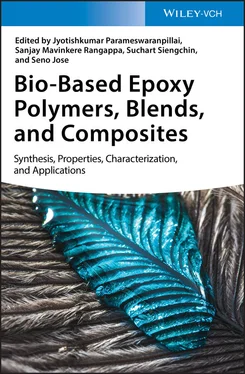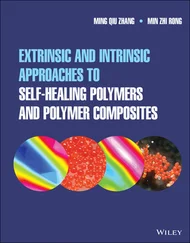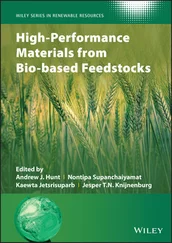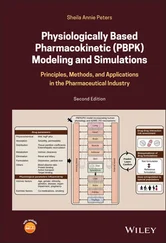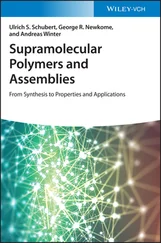The editors are thankful to the contributors of all chapters and the Wiley editorial and publishing team for their kind support. The editors are also thankful to Ms. Junjiraporn Thongprasit (Baifern) for her involvement at the initial screening process of chapters.
20 August 2019
Dr. Jyotishkumar Parameswaranpillai (Thailand)
Dr. Sanjay Mavinkere Rangappa (Thailand)
Prof. Dr.-Ing. habil. Suchart Siengchin (Thailand)
Dr. Seno Jose (India)

Dr. Jyotishkumar Parameswaranpillaiis currently working as a research professor at the Center of Innovation in Design and Engineering for Manufacturing, King Mongkut's University of Technology North Bangkok. He received his Ph.D. in Polymer Science and Technology (Chemistry) from Mahatma Gandhi University. He has research experience in various international laboratories such as Leibniz Institute of Polymer Research Dresden (IPF), Germany, Catholic University of Leuven, Belgium, and University of Potsdam, Germany. He has published more than 100 papers in high‐quality international peer‐reviewed journals on polymer nanocomposites, polymer blends and alloys, and biopolymers and has edited five books. He received numerous awards and recognitions including the prestigious Kerala State Award for the Best Young Scientist 2016, INSPIRE Faculty Award 2011, Best Researcher Award 2019 from King Mongkut's University of Technology North Bangkok.
https://scholar.google.co.in/citations?user=MWeOvlQAAAAJ&hl=en

Dr. Sanjay Mavinkere Rangappa, received his B.E degree (Mechanical Engineering) from Visvesvaraya Technological University, Belagavi, India, in the year 2010, M. Tech degree (Computational Analysis in Mechanical Sciences) from VTU Extension Centre, GEC, Hassan, in the year 2013, Ph.D (Faculty of Mechanical Engineering Science) from Visvesvaraya Technological University, Belagavi, India, in the year 2017, and Postdoctorate from King Mongkut's University of Technology North Bangkok, Thailand, in the year 2019. He is a Life Member of Indian Society for Technical Education (ISTE) and Associate Member of Institute of Engineers (India). He has reviewed more than 50 international journals and international conferences (for Elsevier, Springer, Sage, Taylor & Francis, and Wiley). In addition, he has published more than 85 articles in high‐quality international peer‐reviewed journals, more than 20 book chapters, 1 book, and 15 books as an editor and also presented research papers at national/international conferences. His current research areas include natural fiber composites, polymer composites, and advanced material technology. He is a recipient of DAAD Academic exchange‐PPP Programme (Project‐related Personnel Exchange) between Thailand and Germany to the Institute of Composite Materials, University of Kaiserslautern, Germany. He has received a Top Peer Reviewer 2019 Award, Global Peer Review Awards, Powdered by Publons, Web of Science Group.
https://scholar.google.com/citations?user=al91CasAAAAJ&hl=en

Prof. Dr.‐Ing. habil. Suchart Siengchinis the president of King Mongkut's University of Technology North Bangkok (KMUTNB), Thailand. He received his Dipl.‐Ing. in Mechanical Engineering from the University of Applied Sciences Giessen/Friedberg, Hessen, Germany, in 1999, M.Sc. in Polymer Technology from the University of Applied Sciences Aalen, Baden‐Wuerttemberg, Germany, in 2002, M.Sc. in Material Science at the Erlangen‐Nürnberg University, Bayern, Germany, in 2004, Doctor of Philosophy in Engineering (Dr.‐Ing.) from the Institute for Composite Materials, University of Kaiserslautern, Rheinland‐Pfalz, Germany, in 2008, and Postdoctoral Research from Kaiserslautern University and School of Materials Engineering, Purdue University, USA. In 2016, he received the habilitation at the Chemnitz University in Sachen, Germany. He worked as a lecturer for Production and Material Engineering Department at The Sirindhorn International Thai‐German Graduate School of Engineering (TGGS), KMUTNB. He has been a full professor at KMUTNB and became the president of KMUTNB. He won the Outstanding Researcher Award in 2010, 2012, and 2013 at KMUTNB. His research interests are in polymer processing and composite material. He is the editor‐in‐chief of KMUTNB International Journal of Applied Science and Technology and the author of more than 150 peer‐reviewed journal articles. He has participated with presentations in more than 39 international and national conferences with respect to materials science and engineering topics.
https://scholar.google.com/citations?user=BNZEC7cAAAAJ&hl=en

Dr. Seno Jose, a native of Kerala, India, is an assistant professor of Chemistry at Government College Kottayam. He did his masters in Chemistry in Mahatma Gandhi University. He has availed DST/DAAD fellowship and worked as a visiting researcher at the Institute for Composite Materials Ltd., Germany. He received his Ph.D. in Chemistry from Mahatma Gandhi University in 2007. He has coauthored over 40 peer‐reviewed publications. His research interests include polymer blends, polymer nanocomposites, and shape memory polymeric materials.
https://scholar.google.com/citations?user=uoJt2ckAAAAJ&hl=en
1 Synthesis of Bio‐Based Epoxy Resins
Piotr Czuband Anna Sienkiewicz
Cracow University of Technology, Department of Chemistry and Technology of Polymers, ul. Warszawska 24, 31‐155 Cracow, Poland
The term “epoxy resin” is understood to mean compounds containing at least one active epoxy group in their structure and which are capable of forming a cross‐linked three‐dimensional structure in the curing process involving these groups. Naturally, epoxy rings are found only in vernonia oil. However, epoxy functionality can be easily introduced into the compound structure, even by the oxidation of unsaturated bonds to oxirane rings. This is a typical method of obtaining cycloaliphatic resins, applied on a large scale in electronics to encapsulate electronic systems. The second method is the use of epichlorohydrin, which is commonly applied to prepare epoxy compounds via the reaction with polyalcohols or polyphenols. Epichlorohydrin together with bisphenols (mainly bisphenol A or F, and S) are the main raw materials used in industrial methods for the synthesis of epoxy resins most often produced and used on a large scale. All these compounds are of petrochemical origin. There are three main reasons for the search of new raw materials of natural origin for the synthesis of epoxy resins. The first is the need to replace petrochemical raw materials. The volatility of oil and gas prices and their strong connections with the changing political situation in various regions of the world, as well as the inevitable prospect of imminent exhaustion of their sources, and ecological considerations are the main reasons for the search of alternative sources of raw materials. Moreover, potential toxicological and endocrine disrupting properties of bisphenol A are discussed and emphasized, especially in recent years. The second reason is the need to solve the problem of annually increasing amount of postconsumer plastic waste. Epoxy resins belong to the category of polymeric materials practically not biodegradable. The application of bio‐based raw materials can enable and facilitate their decomposition under the influence of biological factors. Epoxy resins are widely used as coating materials in products intended for contact with food or even storage of food (e.g. can‐coating or paints for securing ship hold walls). Therefore, the third reason is the need to limit the penetration of harmful substances such as bisphenol A into food from the coating material, preferably by eliminating them already at the stage of synthesis.
Читать дальше
